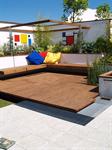 Verandas (or verandahs) are great places to relax. Some of life’s simplest and most enjoyable pleasures take place on the veranda, such as a leisurely Sunday breakfast with the family, morning coffee with a friend, or a quiet evening drink after a busy day at work.
Verandas (or verandahs) are great places to relax. Some of life’s simplest and most enjoyable pleasures take place on the veranda, such as a leisurely Sunday breakfast with the family, morning coffee with a friend, or a quiet evening drink after a busy day at work.
And who can resist those most civilised and appealing of phrases - “Afternoon tea on the veranda?” or “Let’s move out onto the veranda?" Just the very thought of escaping to the veranda seems to make the soul sigh and the pulse slow a little.
The word ‘veranda’ is Portuguese in origin, meaning a porch along the side of a building. Verandas come in all shapes and sizes: they may be partially enclosed, perhaps covered with a roof, and may be positioned at ground level or raised up high. Regardless of size or design styles, verandas are always easily accessed from both inside and outside the building. They differ from balconies, which are high platforms protruding from the side of the building and are often only accessible from inside.
The veranda is, in some respects, an extension of living space, providing a transition zone between the house and the garden. It gives additional space for relaxing and entertaining, and in many cases, gardening. Of course, verandas don’t have to contain plants but they often do. Pot plants and plants in garden beds surrounding the veranda improve the veranda’s appearance and enhance its main purpose – to provide a living space that is relaxing.
A New Veranda
If you are designing/building a new house, or adding a veranda onto an existing one, there are several things to consider, including:
 How much are you prepared to spend? This will have a big impact on the size of the veranda, and the types of materials you might use in its construction.
How much are you prepared to spend? This will have a big impact on the size of the veranda, and the types of materials you might use in its construction.- How much space around your existing house, or new block of land, do you have to accommodate a veranda?
- Are there any obstacles in the way such as trees, services (e.g. septic tanks), or garden beds, that may need to be removed or relocated?
- Will a veranda, or verandas, suit the style of the house?
- Will local council by-laws allow you to have a veranda, or do they dictate the size of the veranda or the types of materials used to construct it? It is important that you check with your local council before spending a lot of time, effort, and money in preparation.
- How big should you make the veranda/s? How it will be used and how many people will it need to accommodate?
Consider the following uses for a veranda:
- An entertainment area - if you have a party with 10 or more people and want a table for food and drink then 3.5m wide (out from the house) is comfortable, 3m is a tight squeeze, and 4m is really comfortable. (Note: To decide on size, try positioning some chairs around an open space and see how many you can get into a given area. Also, think about how many people come to your parties or family get-togethers).
- A play area for children on hot and sunny or rainy days.
- A protected place for your pets to sit (they usually love to sit where they can see indoors).
- An area to grow plants.
- Somewhere to dry clothes on a wet day.
Roofing Your Veranda
The decision to include a roof depends on how much protection you want from sun and rain. A solid roof is great in summer, but it can make adjacent indoor rooms much darker, and a covered veranda can become a heat or cold trap.
Other Considerations
- Do you want to have it partially enclosed to provide some additional protection from the elements?
- Fully enclosed by flywire mesh - this can be costly and restricts access (you can’t pass something easily to someone outside), but if insects are a problem, a screened veranda will get far more use.
- Wood floor, tiles, paving or concrete - tiles, paving and concrete are more durable but wooden floors are more comfortable, especially for small children playing on the veranda. Also, think about how hot or cold the flooring may become, and whether reflected glare from tiles will be a problem.
Using Container Plants
These are great if space is ample, but in a confined space it can be a challenge to 'green-up' the veranda without encroaching on the limited space available. Ideally, pot saucers should be used to protect the floor covering and to prevent any staining.

Making the Most of a Small Space
- Use tall narrow planters rather than low squat ones.
- Use a planter stand or shelving to tier plants vertically.
- Use baskets and wall planters, or window boxes hung outside the veranda space over the railing.
- Choose plants that don’t sprawl, and cut back branches as soon as they get in the way.
- Use space-efficient furniture (e.g. avoid hammocks, rocking chairs, squatters chairs and recliners) unless space is ample.
- Have plants near to, or against, windows indoors - or adjacent to doors that open onto the veranda (such as sliding doors). This way, they appear to be a part of the veranda.
- Rotate plants onto and off the veranda (perhaps to and from a greenhouse, shade-house or protected part of the garden) to create changing interest, and to allow you to display plants on your veranda at their peak (removing them when they are not at their best).
- Place garden beds adjacent to the veranda so that the veranda merges into the plants in the garden bed. However, be careful that the plants don’t grow big enough to block views or encroach onto the veranda space.

Microclimates
A veranda creates a microclimate – which can be hotter, colder, drier, shadier or sunnier – than the rest of the garden. Therefore, you will need to give special care to plants growing on the veranda. The following are ways that microclimates can affect veranda plants:
- Rain – if the veranda is roofed, the plants won’t receive rain so you will need to water the plants frequently.
- Shade – shade from the veranda roof, or from the building walls, will affect plant growth. Light levels can be especially low in winter on south-facing verandas in the southern hemisphere or on north-facing verandas in the northern hemisphere.
- Heat – sun shining directly onto paving and exposed brick walls will raise temperatures, and may burn foliage or dry out soil in containers.
- Frost – plants placed near the house walls on large roofed verandas are much less likely to be damaged by frost.
- Wind – partial screening will help to protect plants.
Maintenance of Plants on Verandas
The following are suggestions as to how you might care for plants grown on verandas:
- Install a drip system - if you have wooden decking, it may be possible to have most of the irrigation system under the decking where it won’t be easily seen, with individual micro-tubes (usually 4mm diameter) coming up through the gaps in the decking right next to the containers so that they won’t be tripped over. Or, place it behind the containers to hide the tubing. Adjustable drippers are slotted into the micro-tubes and placed in position to water the top of the soil in the container. For larger containers, two or more drippers might be used to give a more even watering.
- Use soil wetting agents (if the soil becomes too dry, subsequent watering may not wet the root ball properly).
- Use water storing crystals/granules to help maintain moisture levels in potting mixes.
- The surface of potting mixes can be mulched to reduce moisture losses.
- Place containers so that they are not in a position where they will be exposed to strong winds or to direct sunlight during the hottest part of the day.
- Only feed lightly to maintain healthy growth. Excess feeding will encourage excessive growth, requiring you to water and re-pot your plants more frequently. Lush, soft growth is also more prone to pest and disease attack as well as frost damage.
- Occasionally, take your plants out from under the veranda either into soft rain, or wash them down lightly with a hose, to remove dust and other debris from the foliage